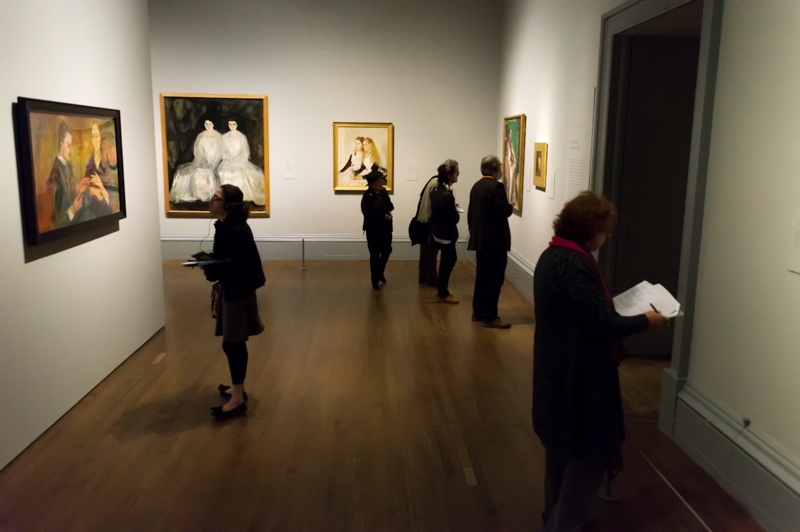
I wanted to like this exhibition. I'm glad the National Gallery avoided a formulaic blockbuster ('Klimt, Schiele, Kokoschka', 'Treasures from the Age of Freud'?). I'm sure uncritical critics would have cooed over a group of secessionist masterpieces, whereas many were nonplussed by this show. Unfortunately it doesn't work.
The idea is to capture Vienna in 1900 rather than focus on the most famous modern masters. But it's all rather incoherent. The earlier Viennese painters like Makart and Amerling don't tell us much about Kokoschka or Klimt and the arrangement is very odd. Wildly different artists are hung together in rooms with themes like 'children', with wall text of glittering generality that tries to tell us something about the role of children in Vienna around 1900. Trouble is, the role of children in Vienna around 1900 isn't particularly distinctive. So we learn neither about the art nor about the social and historical context.
In intellectual history there is a school of research that seeks to recover the context in which political ideas were formed, looking for the meaning of, say, Thomas Hobbes by immersing themselves in seventeenth century English political debate rather than understanding the text itself and its impact on subsequent political thought. I sense that they tried to do something similar here, but the problem is that late nineteenth century Viennese art is not the most meaningful context for the Vienna Secession. The catalogue juxtaposes Kokoschka's Portrait of Hans Tietze and Erica Tietze-Conrat with Rembrandt's Jewish Bride, which makes more sense than setting him alongside Amerling and Waldmüller.
The pictures themselves are mixed. Some are simply dreadful; Schönberg's Self Portrait below is the worst picture I've ever seen at the National Gallery. Others are great, like the Kokoschka, and there are lots of interesting paintings by less well-known artists - a fine portrait by Amerling, and a self-portrait by Franz Eybl, an artist I'd never come across. None of these artists are well represented in British collections, and it's a treat to see them together. But frankly I'd skip this exhibition and see them properly in Vienna. NG exhibitions are quite expensive, and flights relatively cheap. In Vienna the display is better and there's more to see. You can get a proper sense of the distinctive qualities of nineteenth century Austrian art and of the Viennese Secession.

Incidentally the new Titian is now on display at the NG, listed as 'Possibly by Titian' - more cautious than the Burlington article, but I think it's the right label. Condition is poor, but even in its present state the loose brushwork in the drapery looks Titian-esque rather than Titian to me. If you focus in on the man in red at the centre, that part does look good. We can only guess what it was like when freshly done, so I'm cautious of ruling out Titian entirely but it does seem a bit of a stretch. I'm more convinced by the Girolamo Frascatoro. It's an unlovely image, also very damaged, and the attribution has met much scepticism. But I still think it's right, insofar as one can tell in its ravaged state.
Thanks very much, Michael, for this thoughtful and constructive take on the show... I'm hoping to visit this at some point soon, although I'll be coming to it with a much less knowledgeable background. Until I can find the time to go to Vienna I guess this will have to be my substitute!
ReplyDeleteThanks - the show certainly has lots of good things in it, but I found the display bizarre. And having just returned from an exhibition in Madrid, I'm amazed how much better they do wall text at the Prado
Delete"The earlier Viennese painters like Makart and Amerling don't tell us much about Kokoschka or Klimt"
ReplyDeleteEven if we ignore the more detailed treatement the catalogue gives this question, I do think it's interesting to think about what mast it was the patrons of Klimt and Kokoschka were nailing their colours to, as compared with the conservative norm in the preceding period.
Thanks - yes, it's interesting, but I'm not sure we needed an exhibition to show the difference. The contrast between impressionism and the Salon art of the 1860s is interesting, but showing Monet next to Meissonier is revealing of neither. I didn't think the catalogue established its claims well, either. For example, Lehman asserts that the middle classes 'required' a different kind of portraiture than the aristocracy, but she demonstrated only that they patronised different artists. The stronger claim was unproven. There's still much of interest in the exhibition, but I found it less than the sum of its parts.
DeleteI suppose the difference is that, not knowing Salon art in the 1860s at all well, I would indeed be interested in an exhibition in London that put it alongside Impressionism.
DeleteIt's a few weeks since I read the catalogue now and my memory is a bit hazy. I do remember thinking that I liked Gemma Blackshaw's chapters much more than the others, even if she is sometimes a bit obvious in her attempts to seek and cut down conventional wisdom.
Totally agree about the Schönberg, incidentally. If anything it looks even worse in person.
Fair point, but I think it would be more like an illustrated lecture. Links between salon and impressionism are interesting, but seeing the originals side by side isn't especially revealing. Contrast was apparent to me in the wonderful Velazquez exhibition in Madrid - it was especially worthwhile because you could see very similar pictures together, and assess relative quality and attribution in a way that's impossible in a book.
Delete